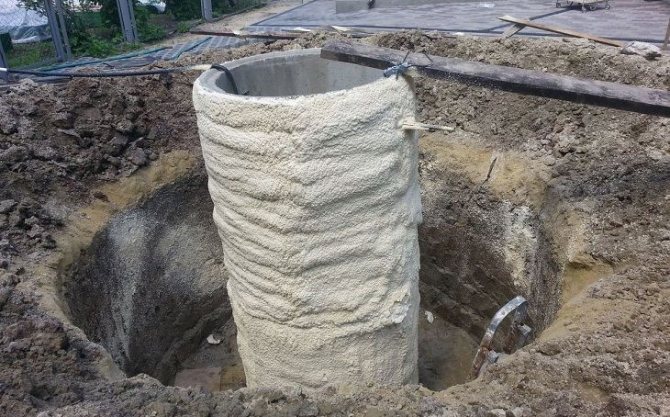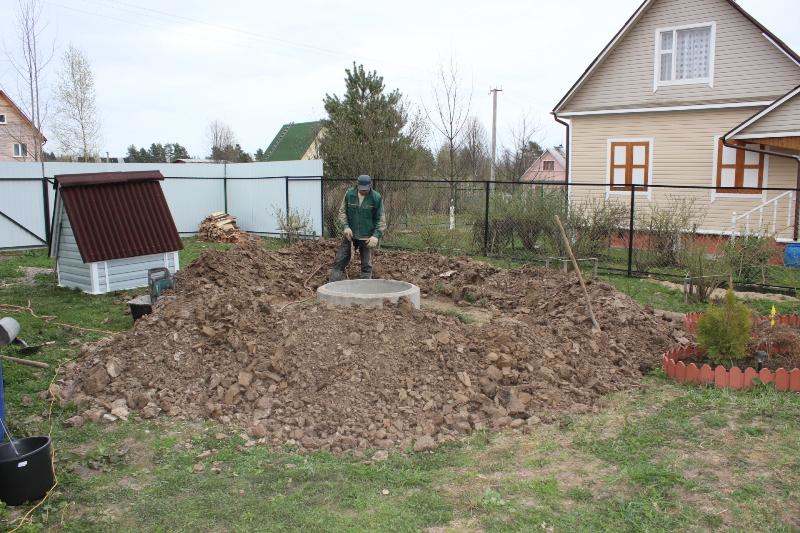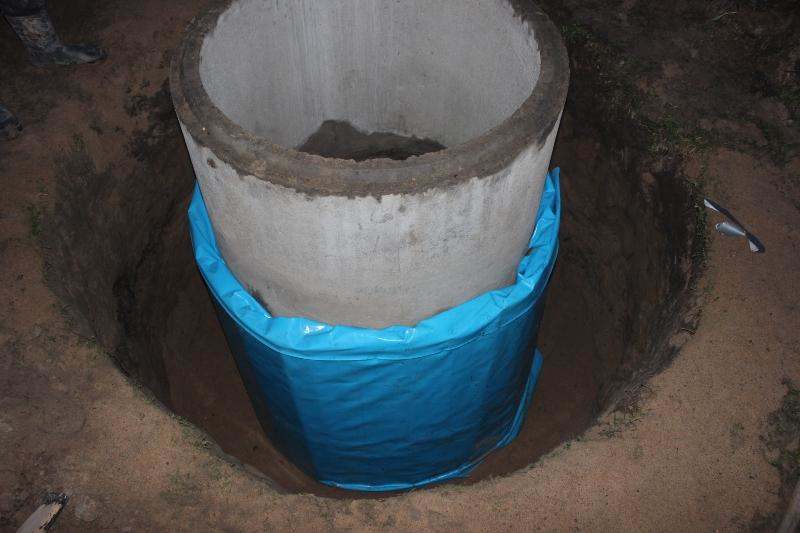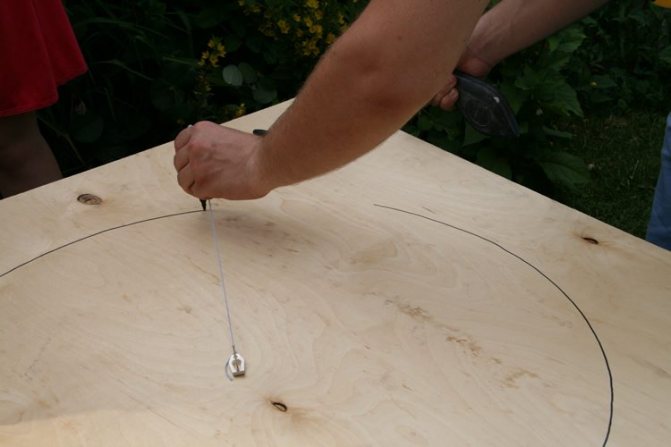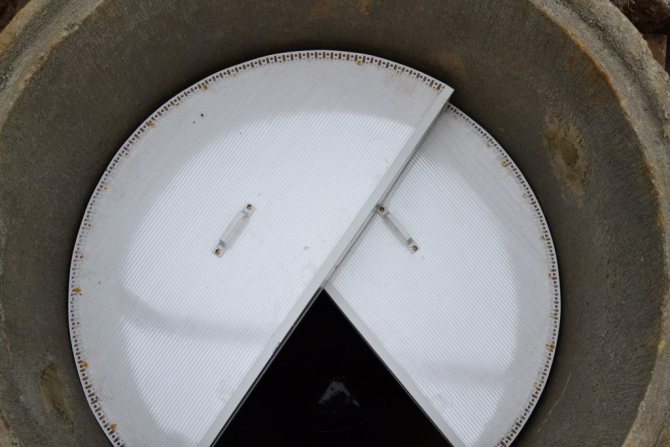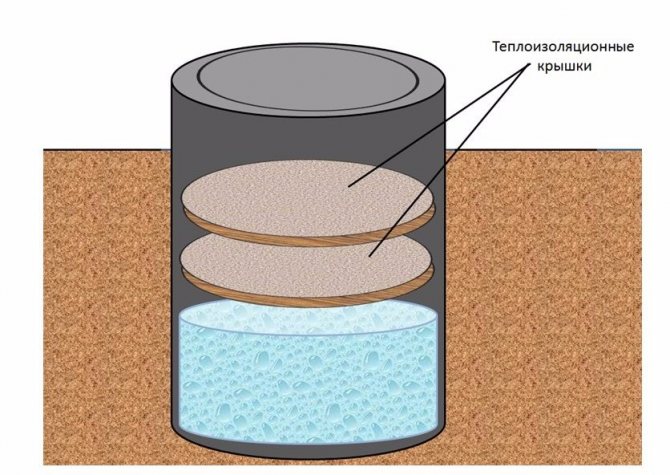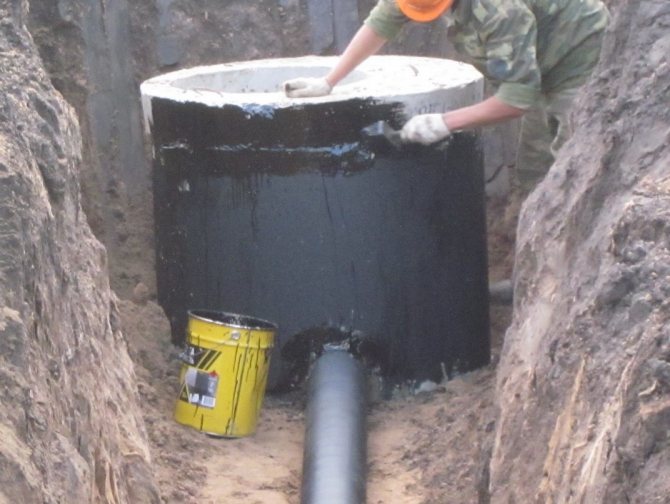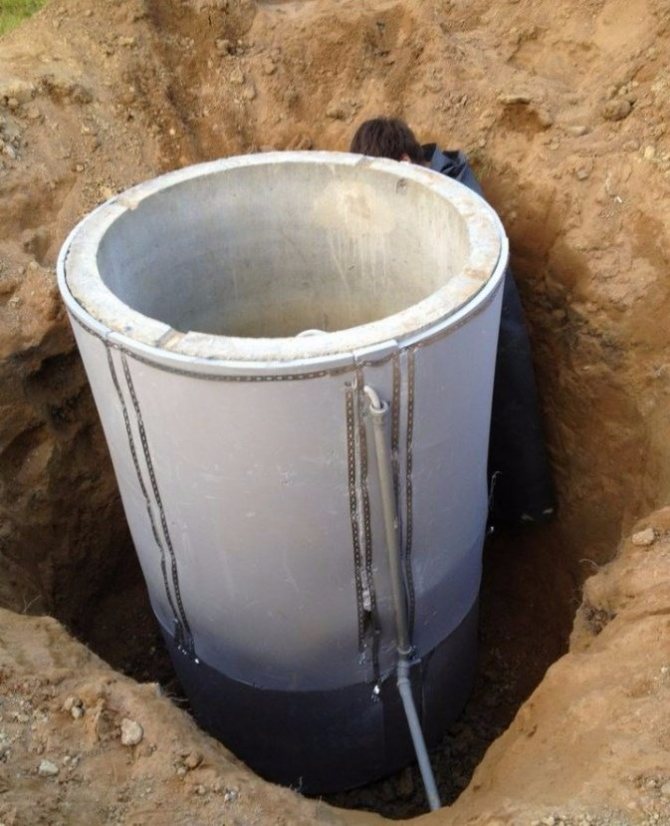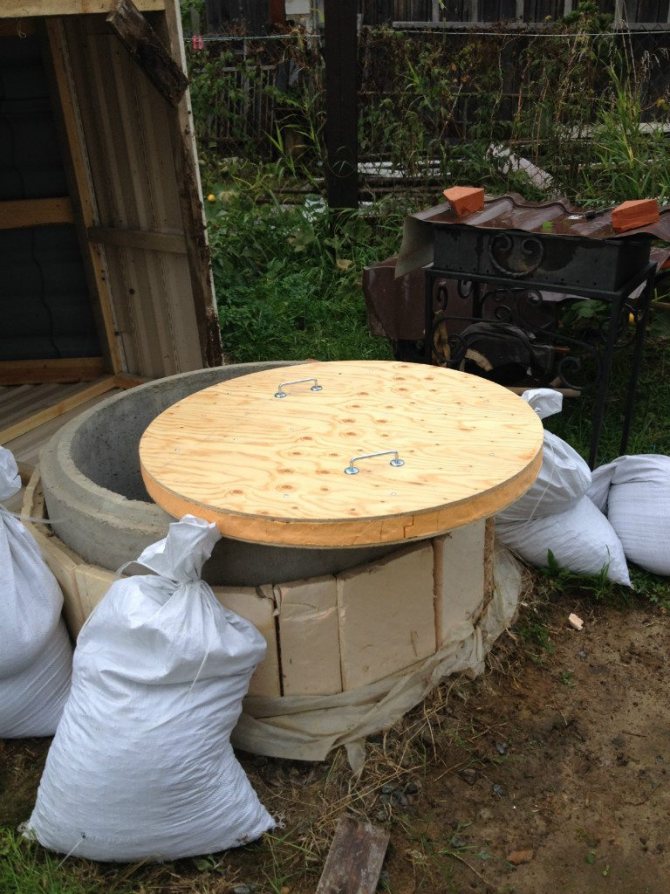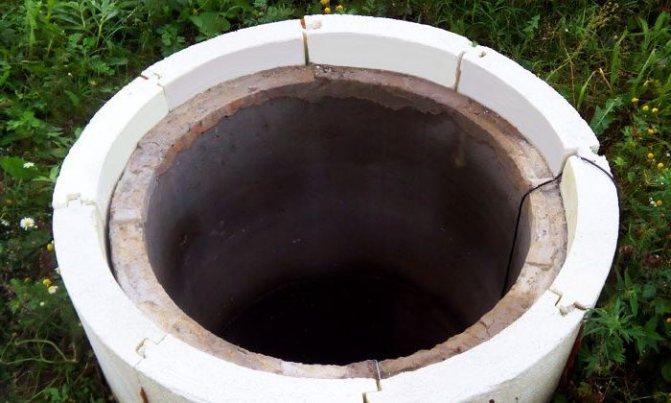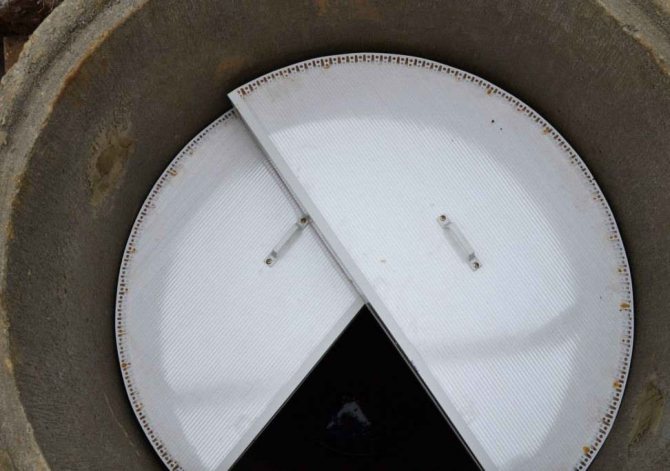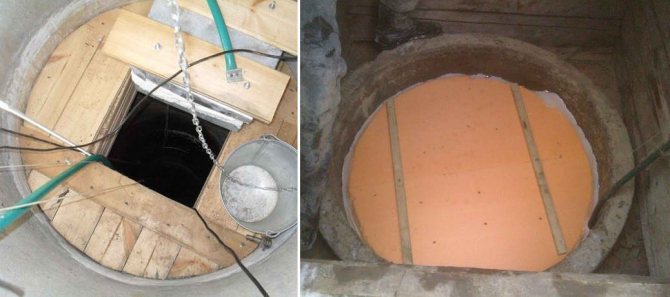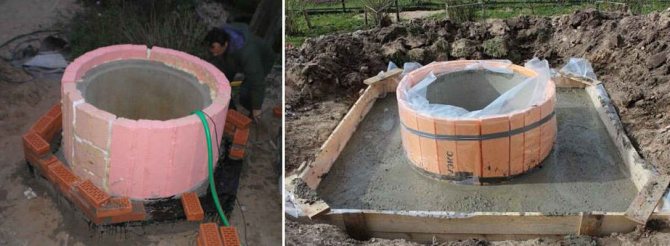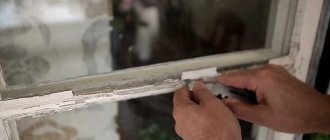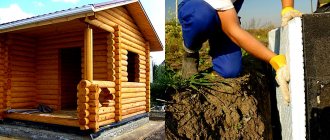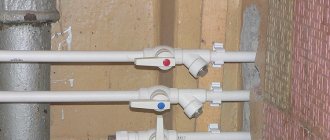Insulation of a summer cottage well from concrete rings
Insulating the topmost ring of the well is actually not so problematic. The technique of this procedure is quite clear and primitive. If you explain briefly and concisely, then the upper concrete ring should be pasted over with familiar polystyrene foam.
Let's consider in detail the progress of work to be performed
- The wall ring needs to be dug out twenty centimeters - to the depth of soil freezing. In total, you will have to go deep about 1.2 meters. Since this is not very comfortable to do, you will have to dig a rather large pit. If you count the rings from above, then it is enough to do with a depth of 20 cm below the junction of the first 2 rings.
- We take layers of foamed polymer and cut it into strips 20 cm wide. High density material is more suitable, and the best option would be to purchase extruded or ordinary foam.
- We clean the wall rings from dust and dirt, moisten them with water, glue parts of the prepared foamed polymer with a special glue.
- When the surface of the ring is fully pasted over, the gaps between the individual strips of foam polymer are filled with foam for installation. Its remains are cut off after complete drying, the soil around the well is poured, the well itself is put in order.
So that the foam for installation work does not burn out in the sun, and the foam polymer does not deteriorate, the structure is reinforced with a mesh, then covered with a plaster layer. This option is very effective, but it does not help in all cases for sure: the cold is able to penetrate through the top.
Thanks to this, it will be better, without delay, to move on to the next method of insulation with your own hands.
Making a warm shutter
What is a warm shutter?
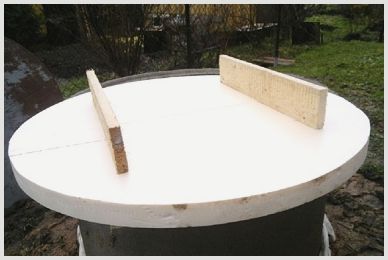
It must be stated that this is a specialized cork with small holes made in it. One of them serves for ventilation and prevents deterioration of water. The second is intended for the intake hose. This option will be optimal for a summer cottage, which is supplied with well water using a pump.
How to make such a shutter cover?
- It is necessary to make two similar rings from plywood resistant to moisture, corresponding to their own dimensions to the inner diameter of the concrete ring of the well.
- One of the rings is pasted over with 5 cm polystyrene foam. All residues are carefully cut off: the foam circle must exactly repeat the shape of the plywood one.
- The second plywood circle is glued on top of the foamed resin.
- Final stage. We drill two 6-centimeter holes (for airing and for a hose), we make a handle to which we attach a thick rope or chain, so that in the spring you can easily remove this plug.
There is nothing difficult in all these events, but there is also no special beauty here.
It should be noted that the considered methods of thermal insulation with foamed polystyrene are suitable only if the water supply is performed using a pump.
If the water comes out of the well with a bucket and a collar, then it is unlikely that the cork will help. In this case, there is another, 3rd method of insulating the well with your own hands.
Insulation of water wells
This is an excellent option for every occasion. There is an optimal way of thermal insulation of a well, which solves several problems at the same time: both the view of the site outside the city will not be able to suffer at all, and the insulation will actually be done with high quality. This primitive and good method is the construction of a special closed well house.
Closed well house
This design solves the following tasks:
- Prevents water from clogging up with foliage and other small debris. A well-thought-out and sealed house with a tight lid will not allow anything unnecessary to get into the source.
- The well will not freeze during the winter. In the only case, such a house will not save from freezing if the water level in the well is higher than the level of ground freezing. If this is the case, then it will also be necessary to implement additional insulation of the upper ring of the wall polystyrene foam.
If you find it too difficult to insulate the well yourself, you can make it easier for yourself. At the very least, you will not need to do most of the work yourself. Foam half rings, a warm shutter, and the sealed good houses themselves can be purchased at hardware stores.
All you need to do is install such products, and this, of course, is several times easier. Well, pre-made products, in most cases, will look much more beautiful than home-made ones. Moreover, this applies to a house for a well. All the same, only self-made interior items will give the site an original and distinctive look.
Does the well freeze in winter?
The question is interesting, our ancestors somehow managed without thermal insulation. And the ensuing question, is it necessary to insulate the well?
Yes, the well freezes, and there are several reasons for this:
- the location of the aquifer above the depth of soil freezing. In this case, the water in the well will freeze, because the temperature of the soil is transmitted to it. If the water level is lower, then there is no need for insulation;
- lack of insulation;
- irrational pipe laying. Plumbing is a system of pipes through which water is supplied to the house. Depending on the depth of their placement, their ability to resist freezing depends. They also need to isolate the place where pipes are inserted into a mine or institution into a house;
- head opening. The difference between the water in the well and the air temperature can exceed 30 ° C. Wooden houses installed on traditional wells prevented direct contact between warm water and cold air. If there is no house, then the water is covered with an ice crust. And the greater the temperature difference, the thicker the crust will be;
- use of material with high thermal conductivity for the construction of a well: bricks, concrete rings, monolithic concrete structures.
The last point answers the question why our ancestors did not freeze their wells - because they were made of wood, and this is the best natural thermal insulation of a well.
In what cases is insulation required
If the well was built according to ancient traditions (read: made of wood), then, of course, it does not need any thermal insulation. There are also exceptions - for example, the well cover needs to be insulated. In this case, it is necessary to make an additional cover of wood and fix it inside the structure itself. This cover will protect the suburban well from:
- falling snow;
- temperature differences;
- dry leaves and other debris.
Note that almost all modern wells are constructed using reinforced concrete rings. Such wells have numerous advantages, including:
- strength;
- reliability;
- durability;
- ease of installation and further maintenance.
Despite this, they have one significant drawback: they need to be insulated for the winter.
On a note! If the water in the structure is located below the freezing level of the soil, then the structure itself will not freeze. But if it is higher, then the installation of an insulating material is required!
There are three technologies for thermal insulation at once:
- insulation of the cover of the structure;
- thermal insulation of the upper ring;
- construction of a decorative house.
Let's get acquainted with each of the possible methods in more detail.
How to insulate a temporary well in the country
But water wells are not always used throughout the year. If it is necessary to carry out thermal insulation of communications that are rarely used, much more difficulties arise. Without operation, the well freezes in winter much faster, because the water does not move in it. In this case, the most successful method would be to install a heating cable. It is placed under a layer of thermal insulation located on the pipe. Such a heating element can be supplemented with sensors that respond to temperature changes.
A less technologically advanced, but cheaper option for warming a temporary well is the arrangement of a small house above its location. Moreover, the house itself must be insulated. Instead of a house, a so-called caisson well can also be used. It is carried out with the help of concrete rings, which are laid to the level of freezing of the soil. At the same time, part of the caisson well should rise above the ground.
With any of the above methods, one must not forget that thorough thermal insulation is still required. Otherwise, neither a decorative house nor a caisson well will save you from freezing.
It should be borne in mind that the construction of a decorative house is a rather laborious event. In addition to the fact that you will have to perform complex work, you will also need to develop a specific project. Of course, if the owner does not want to save money, he can turn to professionals for the preparation of the project. Otherwise, he will have to independently show his imagination. Still, any building on the site must fit into the overall architectural ensemble.
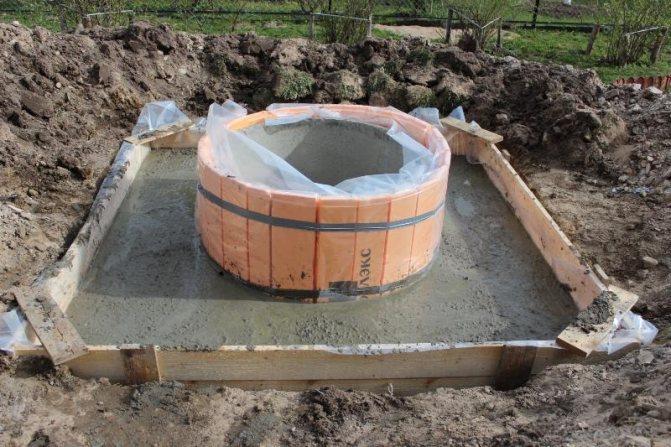

Method two. We thermally insulate the upper ring of the structure
Each specialist will tell you that in order to prevent freezing of the well, it is necessary to reduce the thermal conductivity of its upper ring. This method of thermal insulation is performed in two ways:
- by means of foam;
- by means of polyurethane foam.
Let's look at the first method first.
We use expanded polystyrene for the ring "under the fur coat"
Here you should prepare the following consumables for work:
- polyurethane foam;
- paint;
- plaster;
- insulation blocks made of polystyrene foam, which are connected according to the "thorn-groove" system.
On a note! According to this technology, the first ring from above will be completely insulated, while the second only partially. Now to work!
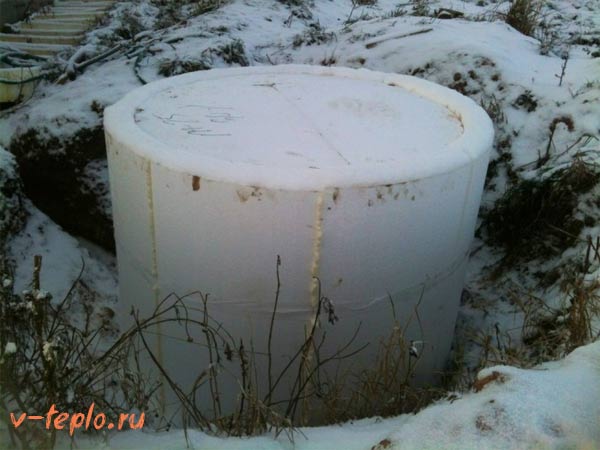

Step one. Work should start with preparatory activities. Around the ring, dig a pit 20 centimeters wide and approximately 0.5 meters deep. Then thoroughly clean the surfaces from dirt and install the first ball of the "fur coat". At this time, make sure that the density of all compounds is maximum! Blow out the joints with polyurethane foam in order to seal them. Having finished with the first level, proceed to assembling the second and gluing it to the ring. Blow out the cracks that have formed between the layers with foam.
Step two. Next, start plastering the surface of the rings. This will protect the foam from the negative effects of the sun's rays, which, as we know, worsen the thermal insulation properties of this material. After the plaster is completely dry, apply paint to it - this will prevent the finish from getting wet.
Step three. It remains only to fill up the pit and carefully compact the earth.
Penoplex, we insulate the foundation reliably and correctly
We advise you to read our article on self-insulation of the foundation. Learn more here
We use polyurethane foam for the ring "under the fur coat"
If you have chosen polyurethane foam as insulation, then follow these steps. First, dig a similar pit (as in the previous method of insulating a well for the winter), and then build a frame made of wood around the first ring.But this is in general terms, we will analyze the procedure in more detail. Prepare the following materials for work:
- paint;
- dowels;
- polyurethane foam sprayer;
- collapsible metal formwork;
- plaster;
- a piece of plastic wrap;
- wooden bars.
Step one. Traditionally, start by digging a pit, but narrower (maximum 10 centimeters). After that, place the bars around the first ring in increments of about 40 centimeters. Cover the edges of the trench with a formwork made of thin sheet steel, which will follow all the contours exactly. Cover the formwork with prepared foil. For what? This is explained by the fact that the adhesion of the foam is very significant, and therefore the dismantling of the formwork is impossible.
Step two. Having finished with the construction of the formwork, you will notice that a void has formed between it and the ring - then you need to fill it with insulation. At the end of the pouring, the polyurethane foam will increase in volume, and the trench will therefore be filled as tightly as possible.
After that, you need to wait until the material is completely dry. As soon as this happens, dismantle the formwork. Plaster the finished surface and apply a coat of paint to it. Cover the void left after the formwork with earth and tamp it thoroughly.
On a note! It is also advisable to cover the well with a lid, which was described in one of the previous paragraphs of the article.
We insulate in different ways
Well insulation options differ depending on what goals are being pursued. It can be partial insulation, it can also be carried out from the inside and outside. Each of them has its own pros and cons. Also, one or more types of insulation are suitable for everyone.
Well cap
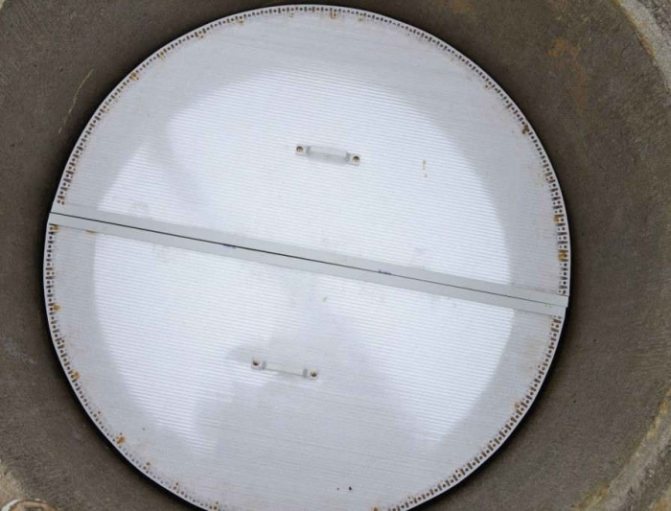

This is one of the easiest ways to insulate. It is suitable in cases where the winters in the region are not too harsh. This process is also called internal insulation. For its implementation, you will need boards, it is better if they are oak. Their length should be slightly larger than the diameter of the shaft. A screwdriver, tape measure, jigsaw or hacksaw, marker or pencil will come in handy from the tool. It is better to choose expanded polystyrene, expanded polyethylene or polyurethane foam as a heater.
Two identical shields are knocked out of the boards. The boards should be tightly adjacent to one another so that there are no gaps between them. If possible, a lock can be made on a milling machine. With the help of a jigsaw or a hacksaw, the shields are given a round shape. The diameter should be slightly less than the inner diameter of the ring so that the lid drops freely inward. The shield, which will be closer to the water, is wrapped in oilcloth or other waterproofing material. This is required so that the wood does not rot from constant exposure to moisture. Insulation is laid on top of it and fixed with foam or self-tapping screws with plastic washers, which will ensure a secure fit.
A second shield completes the entire structure. As a result, you should get a "pie", the "filling" of which is a heater. It is better to close the ends so that the layer is not frayed. It is better not to use polystyrene, since it can crumble and fall into the water, but to catch its task, which will take time. Next, you need a ladder, with its help you need to go down below the level to which the soil usually freezes. Holes are made in the walls, into which the HEX bolts are placed. They will act as a stop for the lid. A holder is made of wire or other material to the lid itself so that it can be easily pulled out and, if necessary, put back. In the case when water is taken out of the well using a bucket even in winter, then a small door is additionally made, which opens with a rope or wire.
Note! Additionally, you can insulate the inside of the well from above and to the level of freezing of the soil.Isolon or other material is suitable for this. With the help of polyurethane foam or umbrellas, it is mounted on the walls of the rings. This should be done only if external insulation is impossible or it will not be an obstacle to using the source.
Building a superstructure is also a good solution. It can be in the form of a house or another shape. Its main purpose will be to compensate for temperature differences by creating an air cushion. In order for it to fully fulfill its role, its design must be to a certain extent airtight, that is, it must not have large slots and not allow direct air streams to pass through. Additionally, such a house for a well is insulated from the outside and sheathed with galvanized metal or film.
External insulation
To insulate a well in this way, there are three main solutions for a well. One of them was mentioned in the note above. Another is to reduce the depth of soil freezing around the well to a minimum. The third is the processing of the outer surface of the well rings. In order to make it easier to decide, it is important to understand:
- how long the freeze lasts;
- how deeply the ground freezes;
- is there permafrost.
If after the analysis it becomes clear that there is no permafrost, and the depth of soil freezing does not exceed 1–1.8 m, then we can do with the insulation of the head of the well. To carry out the work, you will need the following tools:
- shovel;
- roulette;
- polyurethane foam;
- construction knife;
- marking tool;
- board 30 cm wide;
- nails or screws;
- screwdriver or hammer;
- hacksaw.
Using a tape measure, a distance of 0.7–1 m from the well is measured in four directions. Four markers in the form of pegs or pieces of reinforcement are driven in according to the marked marks. A fishing line is stretched between them. It will serve as a guide for the cultivated area. With the help of a shovel, the soil around the well is selected to a depth of 50 cm. It is advisable to do this evenly so that a homogeneous site is obtained. The soil is rammed using mechanical or manual ramming. Further, work is carried out to insulate the head of the well.
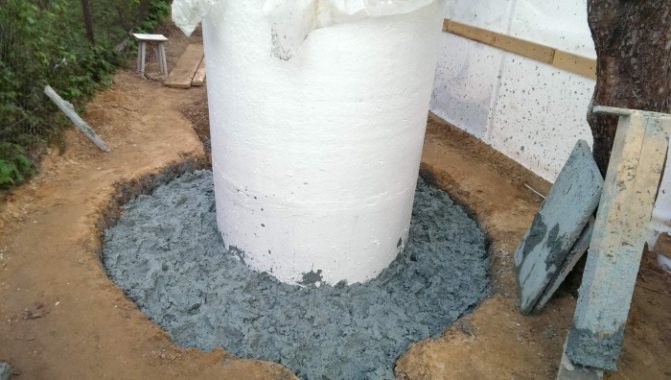

It is good for these purposes of warming a well for the winter with your own hands to use extruded polystyrene foam. It perfectly resists mechanical stress and will last a long time. Several sheets are cut into small rectangles using a construction knife. Their height should be such that it will be equal to the distance from the compacted soil to the top of the well ring. The smaller the width, the easier it will be to repeat the circle. So that there are no gaps between the elements through which cold bridges are formed, they can be cut at an angle so that they fit better. Fixation to the well is carried out using polyurethane foam and construction umbrellas. After the completion of the procedure, a reinforcing mesh is glued and a screed is made with glue. Finishing at the request of the owner.
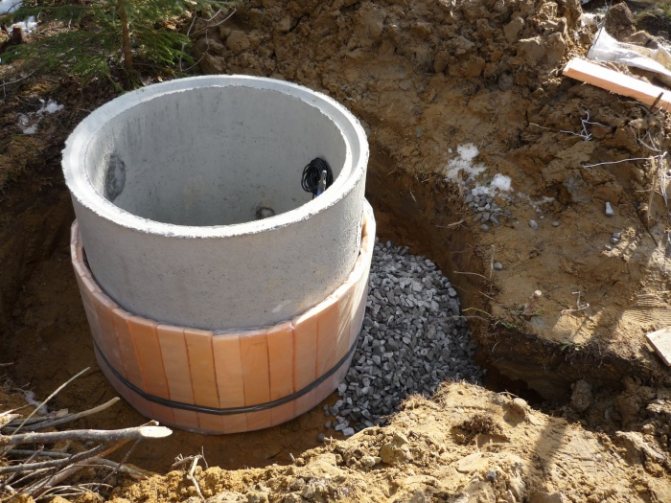

The next step is to make a blind area of a well, which will reduce the level of soil freezing. Coarse river sand is laid on the tamped ground with a layer of 15 cm. It ramps well. To make it easier to do, then it can be moistened with water from a hose or from a bucket. After everything is saturated, a layer of crushed stone or pebbles is laid. Its height is also 15 cm. It is well leveled. Formwork is mounted from the boards. Interlaced reinforcement rods are laid around the well. A solution of cement, sand and crushed stone is being prepared. It is poured into the formwork and leveled. It is better not to do iron, because because of it the surface will become very smooth and will be slippery when wet.
Note! Such an event is usually accompanied by the installation of a house on top.
External insulation inward
This procedure for insulating a well is the most time consuming, but also the most reliable. To implement it, you will need the tools mentioned above.Before starting work on the insulation of the well, it is necessary to go down inside and fasten all the rings with staples, if this has not been done earlier. A trench is dug around the well with a shovel. Its depth should be below the level of soil freezing (at least by 30-50 cm). The walls are periodically cleaned off so that a collapse does not occur and you do not have to repeat everything again and for your own safety.
As a heater for the well, you can use expanded polystyrene in the way described above, but in addition, a waterproofing material is placed on top of it, which will prevent the development of fungus and the destruction of the insulation. The ideal solution would be to apply polyurethane foam. It does not require finishing and will last for many years. If such funds are not available, but the household has reserves of expanded clay, then you can proceed as follows to insulate the well.
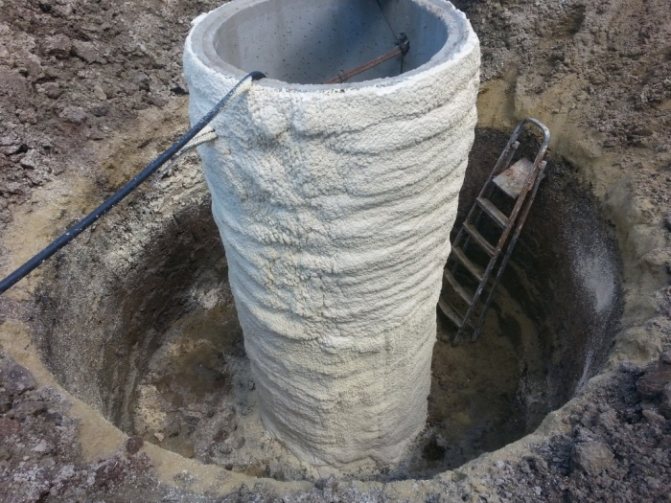

Waterproofing is laid in the dug trench around the well. It can be an oilcloth or a membrane. The latter should be laid in such a way that it gives moisture to the soil, and does not let it back. In this case, the base must cover both the walls of the well, and the bottom, and the outer wall. This is done because expanded clay absorbs moisture very well. And if this happens, then it will completely lose its properties and there will be no sense for the well. Insulation is poured into the formed gutter around the well. The edges of the membrane are wrapped and sealed hermetically. From above, the entire structure is covered with soil and rammed.
Important! A mandatory procedure will be to insulate the place where the pipe from the pump leaves the well and where it enters the house. If this is not done, then the well may be quite functional, but water will not flow into the dwelling.
Construction of a decorative house
The advantages of the house are that it not only insulates the well, but protects the source from dirt and decorates the site as an element of landscape design. Types of well houses:
- roof mounted on mine rings;
- a log house that looks like a gazebo;
- large 2-pitched roof covering concrete rings;
- with a canopy;
- with a winch.
Materials for its construction:
- Brick, building blocks or concrete. With their help, the structure can be given any shape. It is durable and inexpensive, but needs cladding.
- Metal. This option is chosen by lovers of high-tech style. The metal frame is sheathed with sheet metal.
- Natural stone. It is easier to lay flagstone because it is flatter. The house looks natural from it.
- Wood. Due to its high performance and aesthetic appearance, it is chosen most often.
Too thick walls will make the structure bulky, and thin, lightweight structures will not withstand wind and other loads.
The house should not stand on the ground, but on a concrete site. Therefore, work begins with it, taking into account the following:
- the site must be reinforced;
- concrete layer - at least 15 cm;
- it is necessary to make a slope for water flow;
- if a project with a canopy and a winch is selected, the racks for them are installed before the site is poured.
The stages of building a house depend on the materials chosen, but installation always begins with the construction of a frame. After that, the space between the walls of the house and the well is insulated, for example, with expanded clay. The structure is decorated with carvings, painting parts in different colors, artificial aging of wooden surfaces, and setting figures made of wood or plaster.
How to insulate a well for the winter
The well can be insulated in stages. But it is desirable that all the recommended actions be followed. Then the insulation will be of the highest quality. First of all, the upper ring is insulated. A plastic cover made of materials with low thermal conductivity is installed on it.Another option for insulation is to build a decorative house above the well.
You can save on the insulation of the upper ring if you place a cover made of sandwich panels on it. It will turn out to completely make such an element on your own, if you put moisture-resistant plywood on the well, cover it with polystyrene plates on top, and then upholstery with wood.
Today, reinforced concrete covers are also produced for sewer wells. They have a hatch made of polymer materials, which does not need to be removed for the summer. In addition to the fact that such a cover increases thermal insulation, it also extends the operating period of the well as a whole.


It is advisable to immediately choose such a cover option that will have good strength. This is necessary for the reason that the well is additionally insulated in especially severe frosts. For example, you can use snow, cotton blankets and other improvised devices for insulation. If the load on the well turns out to be too large, the unreliable cover simply will not withstand. This should not be allowed, since then you will have to spend money on repairing the structure.
How to insulate a concrete well with foam
For those owners who do not want to spend money on the above procedures, another method can be advised. For the insulation of a concrete well, foam is also used. It is released in the form of a shell, the two halves of which form a closed loop. Here it is important to choose a shell that will fit in its diameter the parameters of the sewer well.
Among the advantages that make foam insulation especially functional are moisture resistance, protection from microorganisms and even the load created by the soil. Also, a positive feature of polystyrene is that it does not lend itself to decay and is environmentally friendly. Such material is very easy to lay if you need to insulate the well.
To carry out the necessary measures, first of all, a trench is prepared along the perimeter of the well. Its depth is 150 cm on average. It is important to reach the level where the freezing of the soil usually stops. Further, the foam shell is installed on the walls of the well, and the trench is filled up. There is nothing complicated in this matter, so the owner can get by with minimal labor costs.
How to insulate a sewer well with your own hands
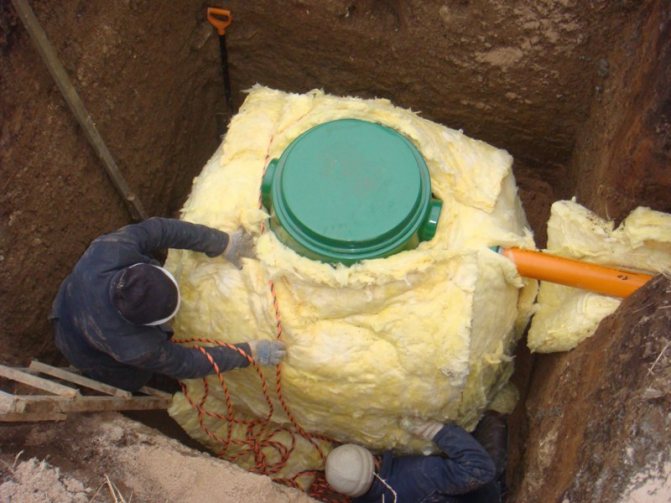

In accordance with building codes, the sewer well must remain sealed. Therefore, its walls and bottom are completely concreted. True, in practice this is not always the case. The fact is that in many cases a sewer well is built using bricks or even car tires. And in the event that reinforced concrete rings are used for this, tightness is still not always possible to obtain.
However, any sewer well must be well insulated. Freezing even such a seemingly secondary communication does not lead to anything good. In this case, the work is carried out in this order.
Thermal insulation of the upper part of the sewer well
At the first stage, the lid should be insulated. Moreover, in addition to this procedure, it will also be useful to insulate the sewer pipe. Then in winter there will be no problems with the outflow of sewage from the house.
If possible, the upper part of the well can be insulated by erecting a decorative house. A design of this kind allows not only to protect communications from the cold, but also to prevent their mechanical damage. But the owner must take into account that such a well itself needs additional thermal insulation. Otherwise, he still cannot protect from the cold.
Laying thermal insulation material around the well
The principle here is similar to that used to insulate a water well.Therefore, you can use the same foam and similar material. It is worth recalling that when insulating with foam or expanded polystyrene, it is better to use a special shell. An annular thermal insulation is made of its two halves, providing protection from the cold along the entire circumference of the pipe. This insulation method is especially effective.
In general, the process of insulating a well is quite simple. In the event that the owner used a very tight cover when arranging the well, in winter he can additionally throw snow on it. This simple method increases thermal insulation, so the risk of freezing is even less. In any case, properly executed thermal insulation will avoid many problems.
Many country house owners use a water well to provide their homes with enough water. But with the onset of winter, there is a very serious need to insulate such an element of water supply lines.
A water well can be insulated on its own, but it is necessary to select the right material for this, as well as to carry out the work themselves in a competent manner.
Preventing the well from freezing
So that with the onset of winter the well structure does not freeze, thermal insulation should be taken care of even during its construction. If the suburban area will be visited occasionally (for example, exclusively on weekends), then, in principle, it is not necessary to insulate the well. In such cases, it is only necessary to clean it and treat it with some kind of disinfectant (such as chloramine) before leaving.
After that, completely pump out the water and close the structure with a lid. Lay a plastic wrap on top of the lid and cover it all with leaves. Now you can go to the city with a clear conscience, because with the onset of heat, the well will again provide clean water.
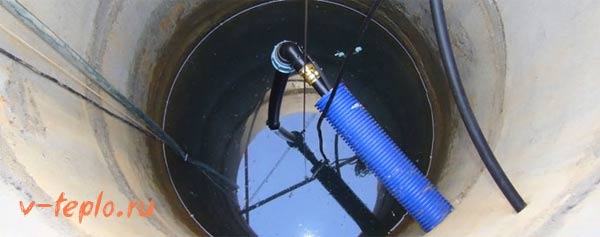

But if the well is operated regularly, then the measures should be more serious. For example, pipes to the house should be located below the soil freezing line, the structure itself should be protected by the house described above, or by other available means.
Why is it necessary to insulate the well?
If the owner doubts that he should insulate the well, it is worth first looking at what freezing can lead to. First of all, thanks to insulation, it will be possible to reduce the risk of damage to structures. If deformation happens, the concrete rings can simply collapse. The negative consequences are reduced to the following phenomena.
- Concrete rings are displaced;
- The seams between the rings are completely torn;
- The entire plumbing system freezes;
- Communications leading to the house are cut off;
- The ground collapses along the perimeter of the well.
Method three. Construction of a wooden house
If your site is located in an area where the temperature in winter is not too low, you can build a protective wooden frame on top of the mine. To do this, prepare:
- wire;
- nails;
- waterproof film;
- logs;
- plywood sheets;
- expanded polystyrene.


Step one. First of all, cover the inside of the top ring with a pre-prepared film. Next, take the styrofoam and cut six rectangles out of it. Make the sizes of the latter such that an even hexagon is formed as a result of covering the ring. This little trick will significantly increase the adhesion density of the foam.
Step two. Then you need to fix the foam. To do this, cover it with at least three rings of ordinary wire. It is advisable to use aluminum wire for this, since it does not rust and is quite soft. As a result, it will be easy to manipulate, and there will be no corrosion on the surface of the insulating layer.
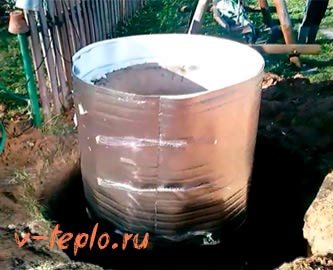

Step three. After that, build a blockhouse of small logs. In height, the log house must be flush with the well itself, and its shape must be hexagonal.Lay a cover consisting of several layers on top of the finished house (as described in the first method of insulation). Then you can paint the structure so that it is not only functional, but also aesthetic.
Video - House installation
For a more detailed acquaintance with the technology, we advise you to watch the thematic video material.
https://youtube.com/watch?v=zFxBdPaUM
Do I need to insulate a water well for the winter?
It is better to protect the well from cold weather in advance. With a significant drop in air temperature, this will already be much more difficult. If the dwelling is located in an area characterized by a harsh climate, and the groundwater on the site is high, the well may simply freeze. But thanks to modern types of insulation, it will be possible to protect against this.
It will be possible to ensure the most successful insulation of the well if you know exactly what the features of a particular climatic zone are, how high the groundwater is located, in which soil the well is located. But first of all, it is necessary to consider the possibilities of those thermal insulation materials that are suitable for performing such work.
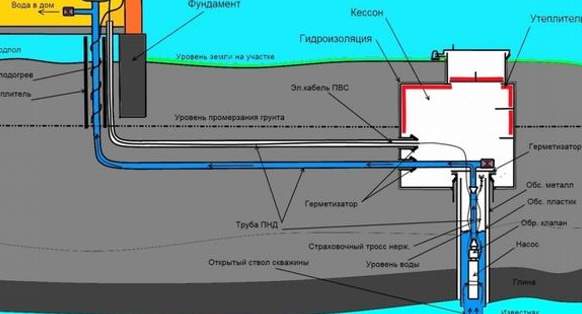

Why is freezing of wells dangerous
It is a mistake to think that well insulation is necessary only when it is used all year round. Many summer residents and seasonal residents of country houses sincerely do not understand why they need to insulate a well, which no one uses in winter anyway. Meanwhile, such seasonal wells also need effective thermal insulation!
Otherwise, a variety of problems may arise that make the operation of the well difficult or completely impossible:
- the formation of an ice plug in the water supply system;
- displacement of the rings resulting from the expansion of frozen water in the enclosing soils;
- breakdown of the ice plug and damage to pumping equipment;
- divergence of the joints of reinforced concrete rings when water gets between the seams.
Wells that are not protected from low temperatures much more often require repair work. And in terms of financial costs, repair activities are often more significant than one-time insulation work.
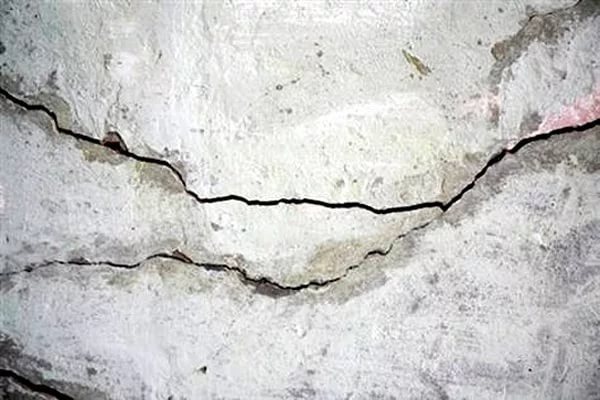

If a water supply system based on a well is arranged in a suburban area, then in addition to the mine itself, it is required to insulate the pipes to protect the supply line of the system from low temperatures.
Do I need to insulate the well
Unlike structures made of natural wood, which is not afraid of exposure to negative temperatures, modern wells without proper insulation can freeze and be damaged. This is due to the high degree of thermal conductivity of reinforced concrete rings.
Wells can freeze even at a certain water level. If it varies within 1.1-2.2 m, then the probability that it will be frozen is extremely high. Only at a great depth of the well, where the water is much lower in relation to the level of freezing of the soil, no troubles happen.
Insulation of a well from concrete rings can be done by hand, without the involvement of specialists Important! In the need to insulate a well, a well, the depth of freezing of the soil in a particular zone plays a significant role. So, in regions with a warm climate, it is up to 0.5 m, moderate - 1-1.5 m, cold - from 1.5 m.
Among the frequent problems that arise with the absence of a heat-insulating layer on the wells, there are:
- The emergence of an ice plug. In conditions of partial thawing, when a thaw occurs, the ice breaks into the water, and entails a break in the cable, damage to the pump.
- Formation of a thin ice film when the temperature drops to -15 ° C. To get to the water and fill the bucket, you need to make an effort, you cannot do without punching it.
- Displacement of reinforced concrete rings, violation of their integrity.As a result of freezing, the volume of water in the well increases greatly, which provokes the expansion of the walls of the hydraulic structure from the inside. Through the cracks that appear, soil particles will enter the mine, melt and rainwater will penetrate, and with them harmful microorganisms. With this approach, the quality characteristics of drinking water deteriorate, and it becomes completely unusable.
- Formation of an ice clot in water pipes. Such a moment blocks all attempts to operate the system normally, here it is necessary to wait for the arrival of heat, then the blood clot will completely thaw. When ice forms, the hoses on the pumping equipment lose their tightness and begin to crack. Considering this, a well, a well equipped with a water meter or pumping device must be effectively insulated.
Method one. Cover insulation
This technology is not complicated and consists in the installation of an additional cover inside the structure itself at the ground level. We remind you that water from a well can be obtained in two ways - in the old fashioned way, that is, with the help of buckets, and by means of an electric pump. This article discusses an exceptionally modern method.
You should start by preparing everything you need. Prepare for work:
- plywood sheet;
- glue;
- wire;
- a plastic pipe, which is necessary for ventilation;
- insulation, the thickness of which will be at least 5 centimeters (foam is ideal for this);
- polyurethane foam.
After that, proceed directly to the construction process.
Step one. Take a plywood sheet and cut out a pair of even circles with a diameter similar to the diameter of the structure itself. Make two holes in each circle - one for the hose and the other for ventilation.
On a note! Ventilation in this case is mandatory, because without it, the water will soon begin to smell unpleasant, and its taste will noticeably deteriorate.
The diameter of the drilled holes is insignificant - no more than 6 centimeters, otherwise frosty air will be able to penetrate through the cracks formed. It is more convenient to drill holes at one edge. Next, along the perimeter of the second circle, make 4 more holes for the wire.
Step two. We continue to warm the well for the winter. Cut out a third circle of the same diameter, but this time from the foam. Stick it on the bottom circle using good quality wood glue, and fix the third circle on top. Once the glue is dry, place a ventilation pipe in the prepared hole. You can use polyurethane foam as a joint seal.
Step three. The work is almost finished, all that remains is to make a special ring out of the wire. To do this, take it and wrap the first ring, thereby fixing its circumference. Then attach the wire to the ring, which is fixed in the four holes of the lower ring. Pass the hose into the required hole and then lower the finished sandwich onto the ground line. The lid will be held with a wire, the well will be properly ventilated, but the water will not freeze.
Well cover and wooden house
To ensure the best protection of the well from freezing, in addition to the insulation of the well shaft, it is also necessary to carry out work on external insulation. They consist in arranging and insulating the cover of the well and / or erecting a wooden house above the well.
The cover for the well must be installed taking into account the maximum water level. The movement of the cover is provided with a cable or rope. The best material for making a lid is wood. Also an excellent option would be a three-layer cover made of two layers of thick plywood with insulation between them.


It is advisable to use expanded polystyrene or polystyrene as a heater.
If you decide to use a well cover made of reinforced concrete, then it must also be insulated by attaching a layer of foam or other insulation. Fastening is carried out using glue for outdoor use and dowel-nails for concrete.
Installing a house over a well is a more costly method, however, it has its advantages:
- reliable shelter of the well shaft from the ingress of debris, precipitation;
- the ability to use the well in any weather (rain, strong wind);
- aesthetic appearance, a wooden house is perceived as an element of landscape design.
You can make such a wooden house yourself or buy a ready-made version. In any case, it is worth knowing that the house is not simply installed on the surface of the earth. He needs a foundation, which is performed as follows: the area around the well is leveled and a blind area is made, on which a layer of fine gravel is poured or tiles are laid.
After that, a wooden house is mounted, and the space between it and the reinforced concrete ring is filled with insulation. In this case, expanded clay, an inexpensive bulk material, can be used as a heater.
How to choose insulation for a well made of concrete rings
To produce high-quality thermal insulation of the well, it is necessary to choose a heater that is not subject to water absorption. It is best to give preference to the following heat insulators:
- Styrofoam. This building material is very popular with consumers. It has a low level of thermal conductivity, adequate cost, ease of use, sufficient resistance to deformation during soil movement. In addition, with foam sheets, no difficulties arise during installation, they are convenient in processing, cutting. A semicircular material can also be purchased on the market. Such elements are easy to fix on concrete rings using umbrella dowels. A waterproofing layer is laid on top. At the end of the work, the pit around the well is protected with soil. The only drawback of polystyrene is its damage by rodents, which take refuge in it for the winter.
- Extruded polystyrene foam. This material is very similar to foam, but has better performance: lower thermal conductivity, increased resistance to serious loads. It is effective to use it for thermal insulation of wells made of concrete rings, but foam plastic wins at the price here. On sale, the material is presented in the form of slabs. The optimum width for insulating a hydraulic structure is 30 cm. They can be laid on the surface of a concrete structure. As for the technology, it is the same as with the use of foam. Upon completion, the joints must be blown out with polyurethane foam.
- Polymer insulation with a cellular structure. The roll heat insulator is characterized by a low level of thermal conductivity, sufficient flexibility, resistance to a humid environment, and heavy loads. It is quite suitable to insulate the well from freezing. Its demanded representatives are isolon, isonel, penolin. There is also a self-adhesive product. In the absence of a sticky layer, it is good to use an adhesive composition for outdoor work on a concrete surface. Docking places in order to avoid moisture penetration into the interior should be glued with tape. The finishing stage will be backfilling the trench with soil.
- Polyurethane foam. The material is applied by spraying onto the surface to be treated. When the mixture hardens, a durable coating will appear that does not need additional waterproofing. Among the advantages of insulation are: low thermal conductivity, plasticity, the ability to withstand heavy loads. The material is not damaged by rodents, insects. Of the minuses, only the high cost, the involvement of specialists.
Important! It is not advisable to use mineral wool for thermal insulation of wells made of concrete rings.Without a proper waterproofing layer, it will quickly absorb moisture from the soil, freeze, and provoke a violation of the integrity of the hydraulic structure.
Why is it necessary to carry out insulation
By insulating the well, it will be possible to preserve a satisfactory temperature inside it, allowing the water to remain in liquid form even in high frosts, without forming ice on the surface.
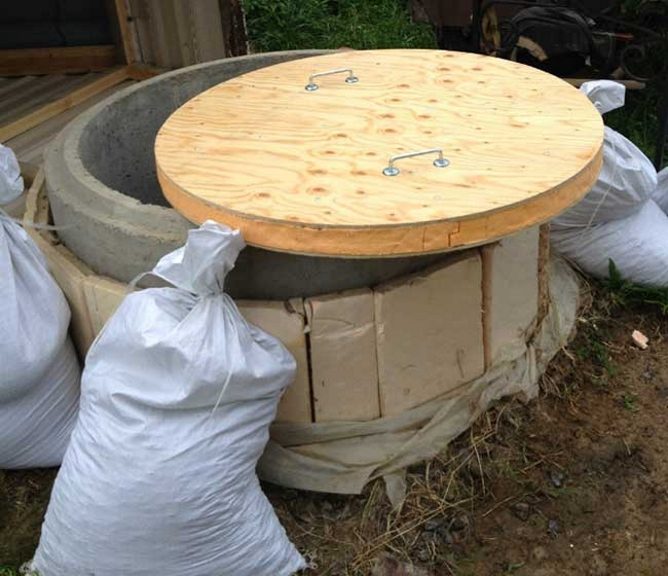

The formation of an ice layer bothers not only the collection of liquid, but can also lead to cracks on concrete circles, or harm the wires or pipes that are located in the well.
The circles begin to break down and age ahead of schedule. As a result, their service life is significantly reduced. In the event of freezing pipes or damage to cables, repairs will be necessary, which will not be cheap and will require time-consuming processes.
How to insulate a well pipe for the winter
During periods when the air temperature drops especially low, it is very important to protect the pipes from freezing. A suitable method in this case is to lay the pipes themselves below the level to which the ground freezes. You can also lay communications using two pipes nested inside each other. The space that remains between the walls of such pipes is insulated with foam plates or mineral wool. The main thing is that the insulation used is completely dry during the laying.
From this it follows that it is necessary to think about well insulation at the moment when its laying is carried out. This will prevent many of the problems that could arise in winter.
It is possible to equip suburban housing in such a way that it turns out to be the most comfortable, only if the sewer pipes are insulated.
There are many methods to achieve a good result in this case. An owner wishing to provide himself with the most comfortable conditions should familiarize himself with the most suitable methods. You can carry out work on the insulation of pipes on your own, having received an excellent effect as a result.
In fact, there are no serious difficulties when insulating sewer pipes. The main thing is that as a result they are well protected and not afraid of freezing. What methods are possible here? It is to them further and it is worth moving on.

